In the animal kingdom, predators rely on their cunning to capture prey. From inescapable traps to deceptive lures, here are some of the animals with the most crafty ways of capturing their prey.
Hidden trapdoors
Trapdoor spiders are masters of ambush and surprise. They build underground burrows where they sit and wait for unsuspecting prey to wander close by.
The best-known trapdoor spiders are those in the family Ctenizidae that build silken, hinged doors above their tunnels. They dig their tunnels beneath busy insect walkways and camouflage them with leaves and dirt.
The spider sits patiently holding the hinged door slightly open, waiting to detect the vibration from an insect crawling. Then, the spider quickly leaps out of its tunnel, capturing its meal with its front legs and pedipalps — antennae-like appendages close to its mouth.
These spiders share features with their close relatives the tarantulas (Theraphosidae) but are less hairy and much smaller in size.
Bubble-blowing nets

Large humpback whales (Megaptera novaeangliae) swim in a circle beneath shoals of fish, releasing bubbles to form a “net” that surround the fish, trapping them in condensed groups. The whales then work together to force the fish close to the surface before taking a gulp.
This hunting method is known as “bubble-net feeding” and is learned among different groups and can change slightly between populations of whales.
Related: Cannibal animals: 12 creatures that gobble up their own kind
Ambush and dismember
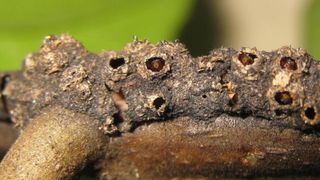
Ants can also do amazing things when they work together.
Azteca brevis is an ant species found only in tropical Central America. They build their black and crusty nests externally along the plant stems of small to medium size trees.
The worker ants bore several holes along these nests, called cartons, and sneakily position themselves directly underneath with their mandibles open. The workers then grab onto the limbs of unsuspecting insects as they walk across the holey stems. They hold down and immobilize the insect before cutting it into little pieces.
Lasso-slinging
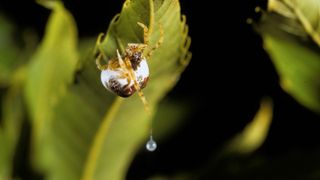
One spider takes a page from Wonder Woman to snag its prey. Meet the female bolas spider (Mastophora hutchinsoni), a predator that spins a sticky lasso to capture her prey.
The huntress produces a chemical odor that mimics the pheromones of female moths, luring in male moths. When the male moths are in sight, the spider creates a long string of silk with a sticky club-shaped end to hurl at the moth’s wings in mid-air.
The female spiders are relatively large, reaching up to 0.8 inches (2 cm) and have huge and distinct white abdomens with humps, probably because they need the heft to take down their hefty prey.
Males, meanwhile, are tiny, at just 0.06 inches (1.6 mm), probably because they have no need to hunt large prey.
Fishing lines and glowing butts
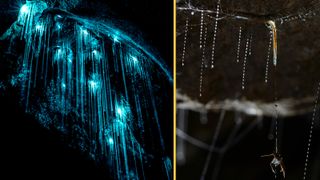
In the dark caves of New Zealand, tiny creatures weave mesmerizing traps with a touch of bioluminescent magic.
These glow worms are not true worms, but are rather the larva of a species of adult fungus gnats called Arachnocampa luminosa.
The larvae circle the top of caves or live in wet bushes. From their mouths, they construct “fishing lines”of beaded mucus up to 20 inches (50 cm) long that they use to hook small flying insects such as mayflies, moths and midges. A single nest can produce up to 150 long strings, according to a 2016 study. The larvae attract these flies with their blue-green bioluminescent backsides. The fishing line is then reeled straight into their mouths. A. luminosa only eat during this part of their life cycle, which can last up to 9 months.
The snake that looks like a spider
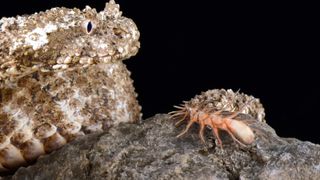
Spider-tailed horned vipers (Pseudocerastes urarachnoides) are incredible mimics found in western Asia. As the name suggests, they have a unique tail that looks like a spider — it has a bulb-like end covered in stretched scales that stick out mimicking the shape of a spider’s body.
The spider-like tail quivers across the floor luring lizards, rodents and sometimes birds who think the spider is lunch. When the prey is distracted by the “spider” on the snake’s tail, the snake pounces.
Baby-saving ploy
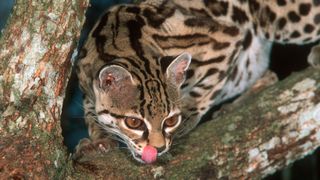
Margays (Leopardus wiedii), small wild cats that live throughout Central and South America, use the instinct of adults to come to the aid of children to lure in their prey.
Margays let out shrieks that mimic the sound of a pied tamarin monkey infant (Saguinus bicolor). This alerts the adults, who venture toward the call to rescue the pup. Once the adults are close enough, the margay pounces.
Local Amazon jungle inhabitants have long heard the margay’s cries in the night, but the first scientific observation of the mimicking call was only recorded in 2009, after locals told scientists that mimicking vocalizations were a common predation technique of cats in the area.
The bird that uses bait to fish
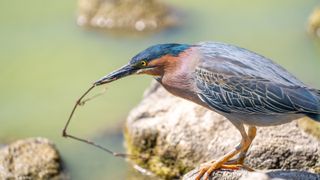
The green heron (Butorides virescens), which lives across North and South America, fishes for its food in a similar way to humans . They green-and-brown birds perch above marshes and drop in scraps of bread, insects and feathers to lure curious fish. Once fish gather, the heron uses its sharp beak to snatch fish out of the water.
The turtle with a tricky tongue
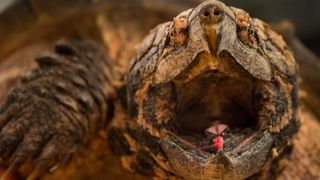
Alligator snapping turtles (Macrochelys temminckii) are the largest species of freshwater turtles, found exclusively in freshwater rivers of America. The common name comes from the large ridge on the back of their hard shells that make them look, from the top, like an alligator, according to North Carolina Zoo.
Their spiked carapaces and dull-colored bodies help them blend into the muddy bottoms of rivers where they sit motionless underwater with their mouths wide open. Their tongue is specifically adapted to look like a tiny worm that wriggles to lure fish inside its jaws.
With a bite force of 1,000 pounds (450 kilograms), the fooled fish are quickly captured and eaten.
Sandpit traps
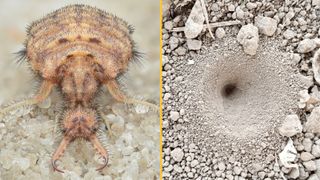
In warm and arid areas of the world, deadly larvae of antlions (Myrmeleontidae) create inescapable sand pits that trap small insects, mostly ants.
In areas of loose soil or sand, the antlion moves in circular motions to create a funnel-shaped pit. The antlion larva buries itself at the bottom of the pit, waiting patiently for an insect to fall in. The larva then grasps infalling insects with its jaws.
If the prey attempts to escape, the larva uses its head to violently fling sand, creating mini landslides that drag the insect back.
Although this hunting strategy is well-known in antlions, only around a third of Myrmeleontid species are known to use pits, according to a 2019 study. Most larvae actively chase their prey or bury themselves under soil, leaves and dry tree holes and lie in wait to ambush their prey.










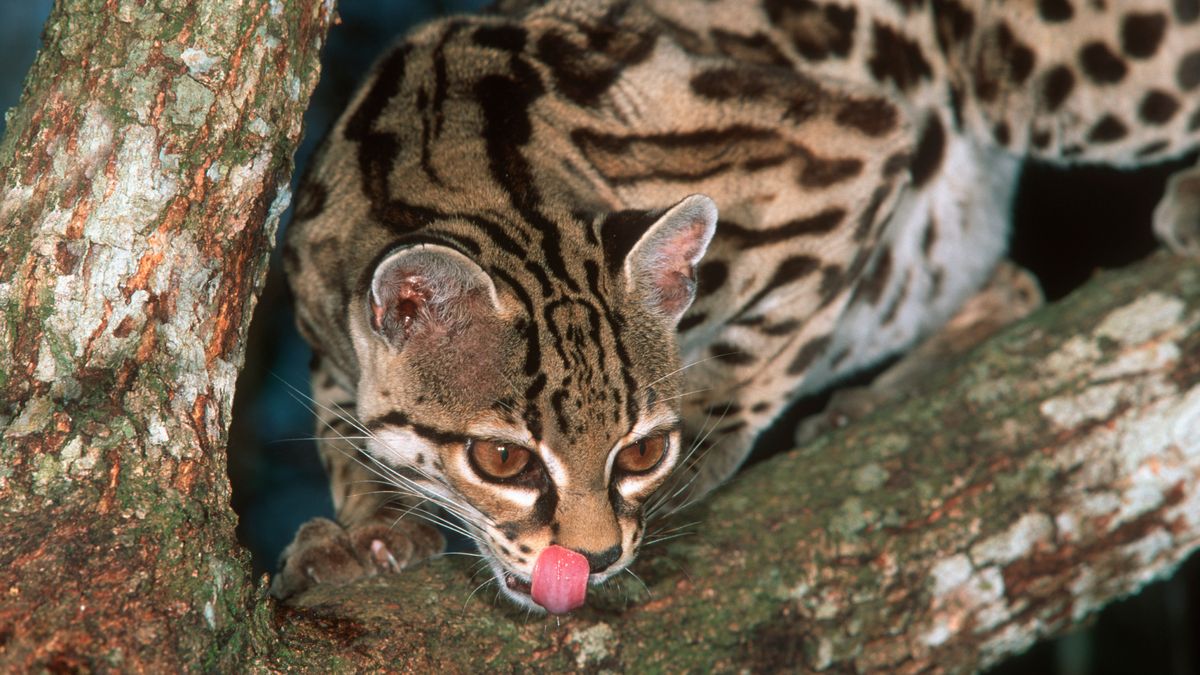
/https://tf-cmsv2-smithsonianmag-media.s3.amazonaws.com/filer_public/34/31/3431771d-41e2-4f97-aed2-c5f1df5295da/gettyimages-1441066266_web.jpg)








Discussion about this post